forest wildlife management and conservation森林野生动物管理与保护
- 格式:pdf
- 大小:355.42 KB
- 文档页数:27
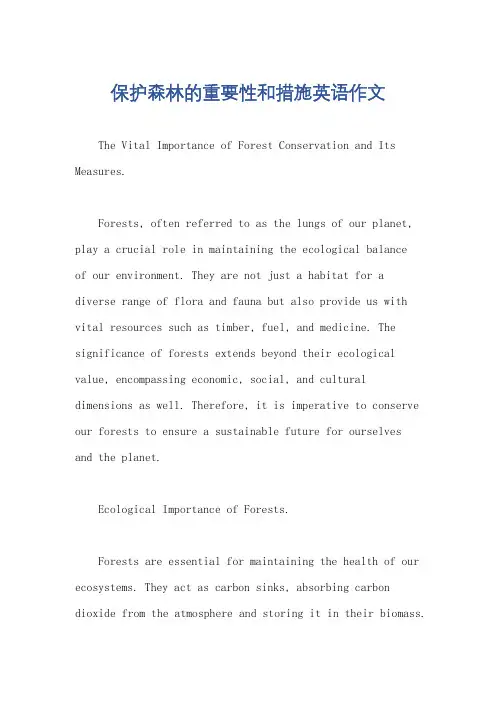
保护森林的重要性和措施英语作文The Vital Importance of Forest Conservation and Its Measures.Forests, often referred to as the lungs of our planet, play a crucial role in maintaining the ecological balanceof our environment. They are not just a habitat for a diverse range of flora and fauna but also provide us with vital resources such as timber, fuel, and medicine. The significance of forests extends beyond their ecological value, encompassing economic, social, and cultural dimensions as well. Therefore, it is imperative to conserve our forests to ensure a sustainable future for ourselvesand the planet.Ecological Importance of Forests.Forests are essential for maintaining the health of our ecosystems. They act as carbon sinks, absorbing carbon dioxide from the atmosphere and storing it in their biomass.This helps mitigate the impact of climate change by reducing greenhouse gas emissions. Forests also contribute to water cycling by regulating rainfall, maintaining water quality, and providing water to streams and rivers.Moreover, forests are home to a diverse array of wildlife, including many endangered species. They provide habitats for these animals, ensuring their survival and maintaining the biodiversity of our planet. The loss of forests can lead to the extinction of these species, resulting in a significant loss of biodiversity.Economic Importance of Forests.Forests are also crucial for our economy. The timber industry, which relies heavily on forests, is a significant contributor to global GDP. Forests also provide us with other valuable resources such as fuel, fruits, and nuts. Additionally, forests play a role in tourism, attracting millions of visitors each year who contribute to local economies through their spending.Social and Cultural Importance of Forests.Forests are integral to our social and cultural lives. They provide spaces for recreation and relaxation, offering an escape from the hustle and bustle of daily life. Forests are also repositories of our cultural heritage, with many traditional practices and beliefs being closely linked to them.Measures for Forest Conservation.In light of the significance of forests, it is imperative to take measures to conserve them. Here are some key strategies that can be employed:1. Sustainable Forest Management: Implementing sustainable forest management practices, such as reducing deforestation and promoting sustainable logging, is crucial for ensuring the long-term viability of forests. This involves harvesting timber in a way that doesn't damage the forest's ecological balance and allows for regeneration.2. Education and Awareness: Educating the public about the importance of forests and the need for their conservation is essential. Initiatives such as public awareness campaigns and educational programs can help raise awareness and encourage people to adopt behaviors that promote forest conservation.3. Protection of Biodiversity: Biodiversity conservation is a crucial aspect of forest conservation. Measures such as protecting habitats and creating safe corridors for wildlife can help maintain the biodiversity of forests and ensure the survival of endangered species.4. Promotion of Alternative Energy Sources: Shifting towards alternative energy sources such as solar, wind, and hydroelectric power can help reduce the demand for fuel from forests, thereby reducing deforestation.5. Strict Enforcement of Laws: Enforcing laws against illegal logging and deforestation is crucial for protecting forests. Stringent laws and penalties for those who violate these laws can help deter illegal activities and protectforests from further degradation.6. Community Engagement: Engaging local communities in forest conservation efforts can be highly effective. Initiatives such as community forestry programs, wherelocal communities are involved in the management and conservation of forests, can help ensure the long-term sustainability of these resources.In conclusion, the conservation of forests is vital for our planet's ecological health, economic prosperity, and social well-being. By implementing sustainable forest management practices, educating the public, promoting alternative energy sources, strictly enforcing laws, and engaging local communities, we can ensure that our forests are protected and preserved for future generations to enjoy.。
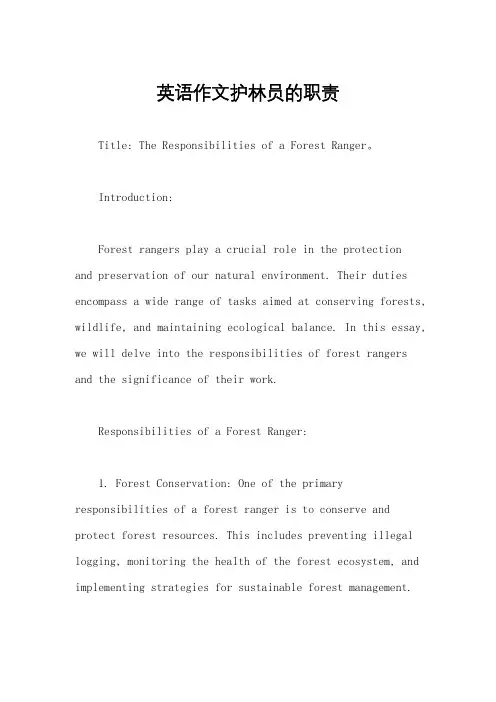
英语作文护林员的职责Title: The Responsibilities of a Forest Ranger。
Introduction:Forest rangers play a crucial role in the protectionand preservation of our natural environment. Their duties encompass a wide range of tasks aimed at conserving forests, wildlife, and maintaining ecological balance. In this essay, we will delve into the responsibilities of forest rangers and the significance of their work.Responsibilities of a Forest Ranger:1. Forest Conservation: One of the primary responsibilities of a forest ranger is to conserve and protect forest resources. This includes preventing illegal logging, monitoring the health of the forest ecosystem, and implementing strategies for sustainable forest management.2. Wildlife Protection: Forest rangers are tasked with protecting wildlife species and their habitats within forested areas. They conduct patrols to deter poaching and illegal hunting activities, as well as assist in wildlife research and management programs.3. Fire Prevention and Management: Forest rangers are on the front lines of wildfire prevention and management. They educate the public about fire safety, conduct controlled burns to reduce fuel loads, and respond to wildfires to suppress them before they spread uncontrollably.4. Public Outreach and Education: Forest rangers engage in public outreach and education efforts to raise awareness about the importance of forests and wildlife conservation. They lead guided tours, give presentations, and collaborate with schools and community groups to promote environmental stewardship.5. Law Enforcement: Forest rangers enforce laws and regulations related to natural resource conservation. Theyinvestigate and address violations such as illegal logging, littering, and vandalism, and work closely with law enforcement agencies to uphold environmental laws.6. Emergency Response: Forest rangers are trained to respond to various emergencies, including medical emergencies, search and rescue operations, and natural disasters. They provide critical assistance during times of crisis and coordinate with other agencies to ensure a swift and effective response.7. Research and Monitoring: Forest rangers conduct research and monitoring activities to assess the health of forest ecosystems and wildlife populations. They collect data on species diversity, habitat quality, and environmental changes, which informs conservationstrategies and management decisions.8. Infrastructure Maintenance: Forest rangers are responsible for maintaining infrastructure within forested areas, such as trails, campsites, and visitor centers. They ensure that facilities are safe and accessible to thepublic while minimizing their impact on the environment.Significance of Forest Rangers:The work of forest rangers is of paramount importancefor the preservation of our natural heritage and the well-being of future generations. By safeguarding forests and wildlife, they help maintain biodiversity, mitigate climate change, and provide essential ecosystem services such as clean air and water. Additionally, forest rangers play avital role in promoting sustainable development andfostering a deeper connection between people and nature.Conclusion:In conclusion, the responsibilities of forest rangers are multifaceted and critical for the conservation of our natural environment. Through their dedication and hard work, they protect forests, preserve wildlife, and ensure the sustainable use of natural resources for present and future generations. As stewards of the land, forest rangers embodythe principles of environmental stewardship and serve as guardians of our planet's precious ecosystems.。

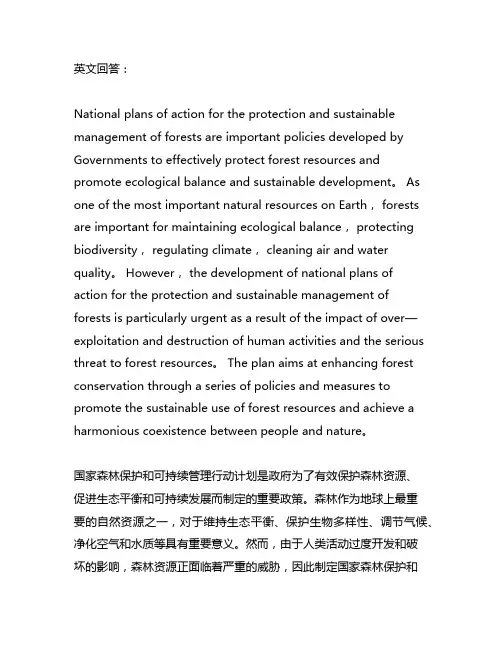
英文回答:National plans of action for the protection and sustainable management of forests are important policies developed by Governments to effectively protect forest resources and promote ecological balance and sustainable development。
As one of the most important natural resources on Earth, forests are important for maintaining ecological balance, protecting biodiversity, regulating climate, cleaning air and water quality。
However, the development of national plans of action for the protection and sustainable management of forests is particularly urgent as a result of the impact of over—exploitation and destruction of human activities and the serious threat to forest resources。
The plan aims at enhancing forest conservation through a series of policies and measures to promote the sustainable use of forest resources and achieve a harmonious coexistence between people and nature。

英语作文-植树造林与森林保护计划Planting trees and forest conservation initiatives are crucial components of environmental sustainability efforts worldwide. Forests play a pivotal role in maintaining ecological balance, mitigating climate change, and preserving biodiversity. In this article, we will explore the significance of tree planting and forest protection programs, their benefits, and the collective responsibility we share in safeguarding our planet's precious ecosystems.Firstly, tree planting serves as a proactive measure in combating deforestation and its adverse effects. Deforestation, driven by urbanization, agriculture, and industrial activities, has led to the loss of vast forested areas globally. By actively planting trees, we can replenish these lost forests, restore degraded lands, and create new habitats for wildlife. Additionally, trees act as natural carbon sinks, absorbing carbon dioxide from the atmosphere and mitigating the impacts of climate change.Moreover, forest conservation programs are essential for preserving the rich biodiversity harbored within these ecosystems. Forests are home to millions of plant and animal species, many of which are endemic and endangered. Protecting forests not only safeguards these species but also maintains the delicate balance of entire ecosystems. Furthermore, forests provide vital ecosystem services such as regulating water cycles, preventing soil erosion, and purifying the air we breathe.Furthermore, tree planting initiatives offer numerous socio-economic benefits to communities around the world. By engaging in reforestation projects, communities can generate employment opportunities, promote sustainable land management practices, and enhance local livelihoods. Additionally, forests contribute to ecotourism, attracting visitors and generating revenue for surrounding communities. Furthermore, access to forests provides communities with essential resources such as timber, food, and medicinal plants, supporting their overall well-being.In addition to the immediate benefits, tree planting and forest conservation efforts yield long-term advantages for future generations. By investing in reforestation andconservation now, we can ensure the continued availability of essential resources and mitigate the impacts of climate change for years to come. Furthermore, educating and involving the youth in these initiatives instills a sense of environmental stewardship and fosters a culture of sustainability.However, the success of tree planting and forest conservation programs depends on collective action and commitment from individuals, communities, governments, and organizations worldwide. Collaboration among stakeholders is essential to implement effective policies, allocate resources, and address underlying drivers of deforestation. Additionally, raising awareness about the importance of forests and promoting sustainable practices is crucial in garnering public support and participation.In conclusion, tree planting and forest conservation programs are integral to preserving our planet's ecosystems, mitigating climate change, and promoting sustainable development. By recognizing the value of forests and taking concerted action to protect them, we can ensure a greener, healthier future for generations to come. Let us embrace our collective responsibility and work together to safeguard the invaluable gift of nature – our forests.。


森林管理计划的英语作文下载温馨提示:该文档是我店铺精心编制而成,希望大家下载以后,能够帮助大家解决实际的问题。
文档下载后可定制随意修改,请根据实际需要进行相应的调整和使用,谢谢!并且,本店铺为大家提供各种各样类型的实用资料,如教育随笔、日记赏析、句子摘抄、古诗大全、经典美文、话题作文、工作总结、词语解析、文案摘录、其他资料等等,如想了解不同资料格式和写法,敬请关注!Download tips: This document is carefully compiled by theeditor. I hope that after you download them,they can help yousolve practical problems. The document can be customized andmodified after downloading,please adjust and use it according toactual needs, thank you!In addition, our shop provides you with various types ofpractical materials,such as educational essays, diaryappreciation,sentence excerpts,ancient poems,classic articles,topic composition,work summary,word parsing,copyexcerpts,other materials and so on,want to know different data formats andwriting methods,please pay attention!As we all know, forest management is crucial for the sustainability of our planet. A well-planned forest management plan can help to maintain a healthy ecosystem, prevent wildfires, and promote sustainable timber harvesting. In this article, we will discuss the key elements of a forest management plan.Firstly, a forest management plan should include a detailed inventory of the forest. This inventory should include information about the species of trees, the age of the trees, the size of the trees, and the overall health of the forest. This information will help to identify areas that require special attention and will help to develop a plan for sustainable timber harvesting.Secondly, a forest management plan should include a plan for fire prevention. This plan should identify areas that are at high risk for wildfires and should outline strategies for reducing the risk of fires. This may includethinning the forest, removing dead trees and brush, and creating fire breaks.Thirdly, a forest management plan should include a plan for wildlife management. This plan should identify species that are at risk and should outline strategies for protecting their habitats. This may include creatingwildlife corridors, protecting nesting sites, and limiting human access to sensitive areas.Fourthly, a forest management plan should include a plan for recreation management. This plan should identify areas that are suitable for recreational activities and should outline strategies for managing these areas. This may include building trails, providing signage, andlimiting access to sensitive areas.Finally, a forest management plan should include a plan for monitoring and evaluation. This plan should outline how the forest will be monitored and evaluated over time to ensure that the management plan is effective. This may include regular surveys of the forest, monitoring ofwildlife populations, and tracking of timber harvesting activities.In conclusion, a well-planned forest management plan is essential for the sustainability of our planet. Byincluding detailed inventories, fire prevention strategies, wildlife management plans, recreation management plans, and monitoring and evaluation plans, we can ensure that our forests are healthy and sustainable for generations to come.。
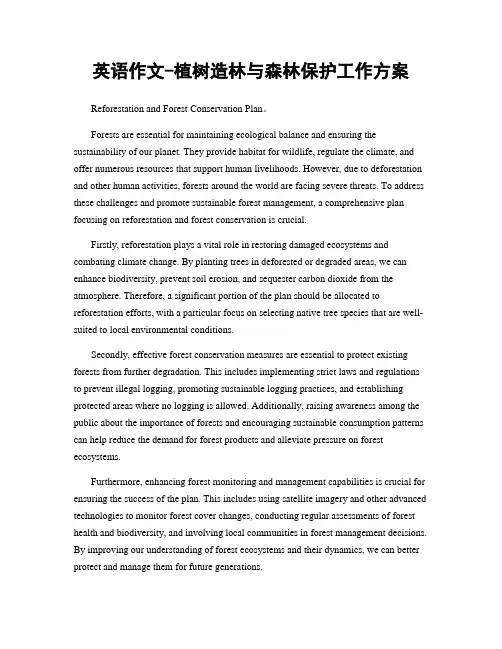
英语作文-植树造林与森林保护工作方案Reforestation and Forest Conservation Plan。
Forests are essential for maintaining ecological balance and ensuring the sustainability of our planet. They provide habitat for wildlife, regulate the climate, and offer numerous resources that support human livelihoods. However, due to deforestation and other human activities, forests around the world are facing severe threats. To address these challenges and promote sustainable forest management, a comprehensive plan focusing on reforestation and forest conservation is crucial.Firstly, reforestation plays a vital role in restoring damaged ecosystems and combating climate change. By planting trees in deforested or degraded areas, we can enhance biodiversity, prevent soil erosion, and sequester carbon dioxide from the atmosphere. Therefore, a significant portion of the plan should be allocated to reforestation efforts, with a particular focus on selecting native tree species that are well-suited to local environmental conditions.Secondly, effective forest conservation measures are essential to protect existing forests from further degradation. This includes implementing strict laws and regulations to prevent illegal logging, promoting sustainable logging practices, and establishing protected areas where no logging is allowed. Additionally, raising awareness among the public about the importance of forests and encouraging sustainable consumption patterns can help reduce the demand for forest products and alleviate pressure on forest ecosystems.Furthermore, enhancing forest monitoring and management capabilities is crucial for ensuring the success of the plan. This includes using satellite imagery and other advanced technologies to monitor forest cover changes, conducting regular assessments of forest health and biodiversity, and involving local communities in forest management decisions. By improving our understanding of forest ecosystems and their dynamics, we can better protect and manage them for future generations.In conclusion, reforestation and forest conservation are integral components of sustainable forest management. By implementing a comprehensive plan that includes reforestation, conservation measures, and improved monitoring and management capabilities, we can help restore and protect our forests for the benefit of current and future generations. Together, we can work towards a greener and more sustainable future for our planet.。

和野兽生活英语作文Title: Living with Wildlife: A Unique Experience。
Living with wildlife can be both thrilling and challenging. It offers a unique insight into the natural world, fostering a deeper appreciation for the creatures we share our planet with. In this essay, I will explore the joys and difficulties of coexisting with wild animals, drawing from personal experiences and observations.One of the most rewarding aspects of living alongside wildlife is the opportunity to witness their behavior up close. From the majestic grace of a deer bounding through the forest to the playful antics of squirrels in the backyard, every encounter provides a glimpse into their world. These moments of connection remind us of theintricate web of life that surrounds us and the importance of preserving it for future generations.However, living with wildlife also presents itschallenges. One of the main issues is finding a balance between coexistence and safety. While we may admire the beauty of a bear or a mountain lion from afar, the realityis that these animals can pose a threat to human safety. Learning how to mitigate these risks while still respecting the natural habitats of these creatures is essential for peaceful coexistence.Another challenge is the inevitable conflicts thatarise when human activities encroach upon wildlife habitats. As urban areas expand and natural habitats shrink, animals are forced to adapt to new environments or risk extinction. This can lead to increased encounters between humans and wildlife, sometimes resulting in negative outcomes for both parties.Despite these challenges, there are steps we can taketo foster harmonious relationships with the wildlife around us. One approach is to minimize our impact on theirhabitats by practicing responsible land management and conservation efforts. This includes preserving green spaces, reducing pollution, and promoting sustainable developmentpractices.Additionally, education plays a crucial role in promoting understanding and empathy towards wild animals. By teaching people about the importance of biodiversity and the role that each species plays in the ecosystem, we can help foster a greater appreciation for the natural world. This, in turn, can lead to more compassionate and informed decisions regarding wildlife management and conservation.In conclusion, living with wildlife is a multifaceted experience that offers both joys and challenges. While encounters with wild animals can be awe-inspiring, they also require careful consideration and respect for their habitats and behaviors. By striving to coexist peacefully with wildlife and taking steps to minimize our impact on their environments, we can ensure that future generations will continue to enjoy the wonders of the natural world.。
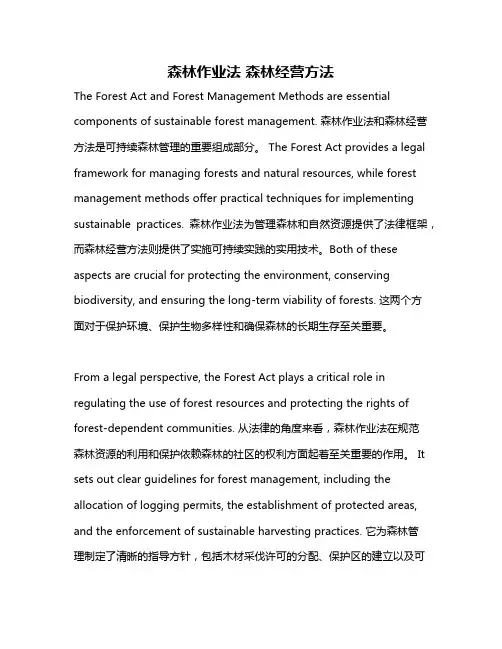
森林作业法森林经营方法The Forest Act and Forest Management Methods are essential components of sustainable forest management. 森林作业法和森林经营方法是可持续森林管理的重要组成部分。
The Forest Act provides a legal framework for managing forests and natural resources, while forest management methods offer practical techniques for implementing sustainable practices. 森林作业法为管理森林和自然资源提供了法律框架,而森林经营方法则提供了实施可持续实践的实用技术。
Both of these aspects are crucial for protecting the environment, conserving biodiversity, and ensuring the long-term viability of forests. 这两个方面对于保护环境、保护生物多样性和确保森林的长期生存至关重要。
From a legal perspective, the Forest Act plays a critical role in regulating the use of forest resources and protecting the rights of forest-dependent communities. 从法律的角度来看,森林作业法在规范森林资源的利用和保护依赖森林的社区的权利方面起着至关重要的作用。
It sets out clear guidelines for forest management, including the allocation of logging permits, the establishment of protected areas, and the enforcement of sustainable harvesting practices. 它为森林管理制定了清晰的指导方针,包括木材采伐许可的分配、保护区的建立以及可持续采伐实践的执行。
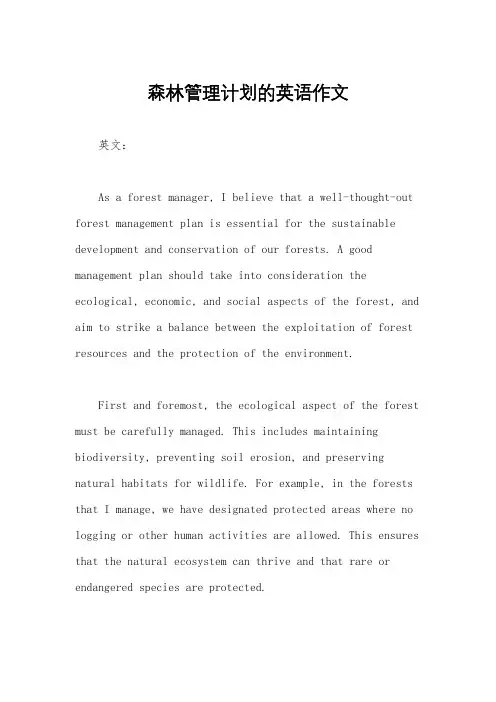
森林管理计划的英语作文英文:As a forest manager, I believe that a well-thought-out forest management plan is essential for the sustainable development and conservation of our forests. A good management plan should take into consideration the ecological, economic, and social aspects of the forest, and aim to strike a balance between the exploitation of forest resources and the protection of the environment.First and foremost, the ecological aspect of the forest must be carefully managed. This includes maintaining biodiversity, preventing soil erosion, and preserving natural habitats for wildlife. For example, in the forests that I manage, we have designated protected areas where no logging or other human activities are allowed. This ensures that the natural ecosystem can thrive and that rare or endangered species are protected.On the economic side, a good forest management plan should aim to maximize the benefits derived from the forest while ensuring its long-term sustainability. This mayinvolve sustainable logging practices, reforestation efforts, and the promotion of non-timber forest products such as mushrooms, berries, and medicinal plants. In my experience, I have seen how a well-managed forest can provide a steady income for local communities while still preserving the forest for future generations.Finally, the social aspect of forest management cannot be overlooked. It is important to involve local communities, indigenous peoples, and other stakeholders in the decision-making process. This can help to ensure that the forest management plan is culturally sensitive and takes into account the needs and concerns of the people who depend on the forest for their livelihoods.In conclusion, a comprehensive forest management planis crucial for the sustainable development and conservation of our forests. By taking into account the ecological, economic, and social aspects of the forest, we can ensurethat our forests continue to provide valuable resources and ecosystem services for generations to come.中文:作为一名森林管理员,我相信一个经过深思熟虑的森林管理计划对于森林的可持续发展和保护至关重要。
爱鸟护林保护生态环境作文600字英文回答:Environmental conservation is the practice ofprotecting and preserving the natural resources of our planet. It includes the protection of forests, wildlife, and ecosystems, as well as the reduction of pollution and waste. There are many reasons why environmental conservation is important. Forests, for example, play a vital role in the global climate system by absorbing carbon dioxide and releasing oxygen. They also provide habitat for wildlife, protect watersheds, and help to prevent erosion. Wildlife is another important component of the ecosystem, as it helps to control populations of pests and diseases, and it provides food and other resources for humans. Ecosystems, which are made up of all the living and non-living things in a particular area, are essential for the survival of all life on Earth. They provide food, water, air, and shelter, and they help to regulate the climate. Pollution and waste can have a devastating impact on theenvironment. Pollution can cause air, water, and soil contamination, and it can harm wildlife and human health. Waste can pollute the environment and clog up waterways and landfills.There are many things that people can do to helpprotect the environment. One important step is to reduceour consumption of resources. We can do this by buying less stuff, choosing products that are made from recycled materials, and recycling or reusing items whenever possible. We can also help to reduce pollution by driving less, using public transportation, and conserving energy in our homes. Protecting the environment is everyone's responsibility. By taking small steps to reduce our impact on the environment, we can help to preserve the planet for future generations.中文回答:爱鸟护林保护生态环境作文600字。
森林草原保护发展计划范文英文回答:Forest and grassland conservation and development plan is of great significance for the protection and sustainable use of natural resources. As an individual, I believe that this plan should focus on the following aspects:1. Biodiversity conservation: Forests and grasslands are home to a wide variety of plant and animal species. It is crucial to protect and restore their habitats to maintain biodiversity. For example, in my country, there is a national park that is known for its diverse wildlife, including rare species like the giant panda. The conservation plan should prioritize the protection of such habitats and promote sustainable tourism practices that minimize the impact on the environment.2. Sustainable forest management: Forests are not only important for biodiversity but also for providing ecosystemservices such as carbon sequestration and water regulation. It is essential to adopt sustainable forest management practices, such as selective logging and reforestation, to ensure the long-term health of forests. For instance, in my community, we have implemented a community-based forest management system where local residents activelyparticipate in forest protection and receive benefits from sustainable timber harvesting.3. Grassland restoration and sustainable grazing: Grasslands are valuable ecosystems that support grazing animals and provide food for local communities. However, overgrazing and land degradation have become major challenges. The conservation plan should include measures to restore degraded grasslands and promote sustainable grazing practices. For example, rotational grazing can prevent overgrazing and allow grasslands to recover, while also providing economic benefits to herders.4. Public awareness and participation: The success of any conservation plan relies on the active involvement of local communities and stakeholders. It is crucial to raisepublic awareness about the importance of forest and grassland conservation and encourage people to participatein conservation activities. For instance, educational programs can be organized to teach students about the value of nature and the need for its protection. Additionally, community-based initiatives such as tree planting campaigns and clean-up events can engage people in hands-on conservation activities.中文回答:森林草原保护发展计划对于自然资源的保护和可持续利用具有重要意义。
爱鸟护林,保护生态英语作文600Love Birds, Protect Forests, and Conserve the Ecosystem.The harmonious coexistence of humans and nature is crucial for a sustainable and thriving planet. Amidst the tapestry of life, birds hold a special significance as guardians of our forests and protectors of our ecosystem. Their presence not only enriches our lives with their melodious songs and vibrant hues but also plays a vitalrole in maintaining the delicate balance of nature.Forests, the lungs of our planet, provide countless benefits to humanity. They purify the air we breathe, regulate the climate, and serve as havens for anastonishing array of plant and animal species. Birds, as integral members of these diverse ecosystems, fulfill indispensable roles that are vital for the health and stability of our forests.One of the primary contributions of birds to forestecosystems is their role as seed dispersers. As birds travel from tree to tree in search of food, they carry seeds with them, inadvertently planting new trees and contributing to the regeneration of forests. This process is crucial for maintaining genetic diversity within plant populations and ensures the continued existence of various tree species.In addition to seed dispersal, birds also play a vital role in insect control. Many bird species feed on insects, including those that can damage trees and spread diseases. By consuming these insects, birds help to regulate insect populations and protect forests from pests. This natural pest control provided by birds reduces the need for chemical insecticides, which can have harmful effects on both the environment and human health.Furthermore, birds contribute to nutrient cycling within forest ecosystems. Through their droppings, birds distribute nutrients throughout the forest, enriching the soil and making it more fertile. This process supports the growth of healthy trees and other plant life, furtherenhancing the overall productivity of the forest.Beyond their ecological contributions, birds also have cultural and aesthetic significance for humans. Their presence in forests brings joy and wonder to those who venture into these natural sanctuaries. The melodious songs of birds create a symphony of sound that enriches our experiences and connects us to the natural world. Birdshave inspired countless works of art, literature, and music, showcasing their enduring impact on human culture.In light of their multifaceted importance, it is imperative that we take collective action to protect birds and their habitats. Deforestation, habitat loss, and pollution pose significant threats to bird populations worldwide. By supporting conservation efforts, reducing our carbon footprint, and promoting sustainable practices, we can create a future where birds continue to thrivealongside humans in healthy and vibrant forests.One crucial aspect of bird conservation is the preservation of their habitats. Protecting forests,wetlands, and other natural areas where birds reside is essential for ensuring their survival. Governments, conservation organizations, and individuals alike can playa role in safeguarding these habitats through land acquisition, habitat restoration, and responsible land management practices.Minimizing our carbon footprint is another important step in protecting birds and forests. Climate change posesa serious threat to bird populations, leading to habitat loss, altered migration patterns, and increasedvulnerability to disease. By adopting low-carbon lifestyles, reducing our energy consumption, and investing in renewable energy sources, we can mitigate the impacts of climate change and create a more sustainable future for birds and humans alike.Finally, promoting sustainable practices is key to protecting birds and forests. This includes reducing our consumption of resources, recycling and composting waste, and choosing products that are made from sustainable materials. By making conscious choices in our daily lives,we can contribute to a circular economy that minimizes waste and preserves natural resources.In conclusion, birds are indispensable allies in the preservation of our forests and the well-being of our planet. Their roles as seed dispersers, insect controllers, and nutrient cyclers are vital for maintaining the health and productivity of forest ecosystems. Moreover, birds enrich our lives with their beauty, songs, and cultural significance. It is our collective responsibility to protect birds and their habitats through conservation efforts, sustainable practices, and responsible land management. By fostering a harmonious coexistence between humans, birds, and forests, we can ensure a thriving and sustainable future for all.。
森林管护流程及内容Forest management is a critical process that involves the protection and sustainable use of forest resources. 森林管护是一个至关重要的过程,涉及保护和可持续利用森林资源。
It is essential for maintaining ecological balance, preserving biodiversity, and promoting the well-being of both wildlife and humans. 这对于维持生态平衡、保护生物多样性,以及促进野生动植物和人类的福祉至关重要。
Forest management includes a range of activities such as forest monitoring, fire prevention, pest control, and reforestation. 森林管护包括一系列活动,如森林监测、防火、害虫防治和重新造林。
One of the key aspects of forest management is the development of comprehensive management plans that address the long-term sustainability of the forest ecosystem. 森林管护的一个关键方面是开发综合管理计划,以解决森林生态系统的长期可持续性问题。
These plans consider factors such as the health of the forest, the needs of local communities, and the impact of human activity. 这些计划考虑了森林的健康状况、当地社区的需求以及人类活动的影响。
保护森林和野生动物的重要性英语作文The Importance of Protecting Forests and WildlifeForests and wildlife are critical components of our ecosystem, playing a crucial role in maintaining the balance of our planet. Protecting forests and wildlife is essential for the survival of not only the species that inhabit them but also for the well-being of the entire planet.Forests are often referred to as the lungs of the Earth, as they absorb carbon dioxide and release oxygen through the process of photosynthesis. This helps to regulate the levels of greenhouse gases in the atmosphere, mitigating the effects of climate change. Additionally, forests provide habitat for a wide variety of plant and animal species, many of which are unique and irreplaceable. By protecting forests, we can safeguard biodiversity and prevent the extinction of endangered species.Furthermore, forests play a crucial role in regulating the water cycle, helping to prevent soil erosion and maintain the fertility of the land. They also provide valuable resources such as timber, medicine, and food for local communities. By conserving forests, we can ensure that these resources remain available for future generations.In addition to forests, wildlife also plays a vital role in maintaining the balance of ecosystems. Animals help to pollinate plants, disperse seeds, and control pest populations, contributing to the health of ecosystems. By protecting wildlife, we can help to preserve the delicate balance of nature and prevent the collapse of entire ecosystems.Unfortunately, forests and wildlife are facing numerous threats, including deforestation, habitat destruction, poaching, and climate change. These threats are pushing many species to the brink of extinction, with devastating consequences for ecosystems and human societies.It is imperative that we take action to protect forests and wildlife before it is too late. Governments, businesses, and individuals all have a role to play in conservation efforts. Governments can enact and enforce laws to protect forests and wildlife, while businesses can adopt sustainable practices that minimize their impact on the environment. Individuals can also make a difference by supporting conservation organizations, reducing their carbon footprint, and advocating for the protection of forests and wildlife.In conclusion, protecting forests and wildlife is essential for the health of our planet and the well-being of future generations.By working together to conserve these vital resources, we can ensure a sustainable future for all living beings on Earth. Let us all do our part to protect forests and wildlife for the benefit of our planet and future generations.。
护林员的英语作文Title: The Responsibilities and Challenges of a Forest Ranger。
A forest ranger plays a crucial role in protecting and managing our natural resources. The job requires dedication, knowledge, and a deep commitment to preserving our environment. In this essay, we will explore the responsibilities and challenges faced by forest rangers.Responsibilities of a Forest Ranger。
Firstly, let's delve into the responsibilities of a forest ranger. A forest ranger's primary duty is to ensure the conservation and sustainable use of forest resources. This involves monitoring the health of the forest ecosystem, preventing illegal activities such as logging or poaching, and conducting patrols to enforce regulations.Another key responsibility is fire management. Forestrangers must be vigilant during dry seasons to prevent and suppress wildfires. They often work with firefighting teams to contain and extinguish forest fires swiftly, minimizing damage to the ecosystem.Furthermore, forest rangers are tasked with educating the public about conservation. They may organize guided tours, workshops, and outreach programs to raise awareness about the importance of forests and wildlife preservation.Challenges Faced by Forest Rangers。
THE YEAR IN ECOLOGY AND CONSERVATION BIOLOGY,2009Forest Wildlife Managementand ConservationDavid B.LindenmayerFenner School of Environment and Society,The Australian National University,Canberra,AustraliaForests are critical for the world’s biodiversity,the regulation of the Earth’s climate,and the provision of goods and services for humans.This review focuses on four broad top-ics:(1)key processes threatening forest biodiversity;(2)broad strategies for mitigating threatening processes;(3)climate change and forest biodiversity;and,(4)plantations and biodiversity.How key issues within these broad topics are addressed will have pro-found effects on forest biodiversity and the Earth’s climate.A significant global problem for biodiversity conservation is the conversion of natural forests to other land uses,both in developing and developed nations;ways must be urgently identified to halt forest con-version.When forests are logged for timber or pulpwood and then regenerated,impacts on biodiversity are harder to quantify than when forests are converted to other land uses.Hence,the effectiveness of efforts to mitigate such impacts(where they occur)is frequently not well known.Climate change may result in substantial changes to forest ecosystems,and its effects may interact in additive or cumulative ways with other hu-man disturbances in forests,although work on such combinations of impacts is in its infancy.The establishment of plantations of trees is frequently proposed to sequester large amounts of carbon and/or produce biofuels to mitigate the climate-change effects. However,there is potential for perverse outcomes,such as biodiversity loss where plan-tation establishment is narrowly focused and other environmental values are ignored. Key words:forests;biodiversity;reserves;off-reserve management;climate change; plantations;adaptive management;monitoringIntroductionNative or natural forests are among the most species-rich environments on earth,making them critical reservoirs for many groups of biota ranging from vertebrates to microbes(Torsvik et al.1990;Gill1995;Crozier et al.1999).Na-tive forests are also key stores of forest carbon (IPCC2007;Mackey et al.2008)and as a result have a major role to play in the mitigation of climate-change impacts.It is not the aim of this chapter to comprehen-sively review the broad range of topics within forest management and forest biodiversity con-Address for correspondence:David B.Lindenmayer,WK Hancock Building West(43),The Australian National University,Canberra,ACT, 0200,Australia.david.lindenmayer@.au servation.This would be an almost impossible task given the massive proliferation of journals and other kinds of literature examining such subjects.Nor does this review attempt to repeat the considerable content of key texts on for-est biodiversity conservation(e.g.,DeGraff and Miller1996;Hunter1999;Lindenmayer and Franklin2002).Rather,this review examines a subset of existing and emerging issues associ-ated with the management and conservation of the world’s forests and forest biodiversity. Four broad(and strongly interrelated)top-ics are covered:(1)key processes threatening forest biodiversity.(2)broad strategies for miti-gating threatening processes.(3)climate change and the conservation of forest biodiversity.and (4)plantations,biodiversity conservation,and the risks of“bio-perversity.”A brief overview of each topic is accompanied by a discussion ofThe Year in Ecology and Conservation Biology,2009:Ann.N.Y.Acad.Sci.1162:284–310(2009). doi:10.1111/j.1749-6632.2009.04148.x C 2009New York Academy of Sciences.284Lindenmayer:Forest Wildlife Management&Conservation285complexities,challenges,and unresolved issues. Thefinal part of this review touches on some key challenges for the conservation and man-agement of forest ecosystems and identifies some of the knowledge gaps that need to be closed.Processes Threatening Forestsand Forest Biodiversity Several key factors threaten,or have the po-tential to threaten,forest biodiversity.Four of these are(1)forest conversion to other forms of land cover,(2)logging,(3)salvage logging, and(4)altered natural-disturbance regimes. They are briefly discussed in the remainder of this section and are a prelude to the follow-ing one on mitigating their impacts.An entire section of this review is dedicated to a brief dis-cussion of afifth threatening process—climate change.Forest ConversionForest conversion is the clearing and replace-ment of native forest with some other kind of land cover,such as for grazing for domestic live-stock and agriculture,plantation establishment, and urban settlement.Land conversion is one of the greatest threats to native forests and forest biodiversity on all of the Earth’s vegetation continents and in both developed and developing nations.For-est conversion removes habitat for many forest-dependent species.This is a major issue because habitat loss is the primary driver of species loss worldwide(reviewed by Groombridge and Jenkins2002;Fahrig2003;Lindenmayer and Fischer2006;Schipper et al.2008). Calculating annual rates of forest conversion is problematic because of inadequate satellite coverage and arguments over definitions of for-est clearing.The Food and Agraculture Organ-isation of the United Nations(FAO2007)esti-mates that0.3%of the world’s area of forests or 13million ha is cleared annually.Annualfigures for tropical humid forests are∼120,000km2 with most of the world’s14–18million km2now cleared,primarily in the last50years.For trop-ical dry forests,annual rates of conversion have been estimated to be40,000km2(Chivian and Bernstein2008).Such estimates of forest con-version do not include the area of forest subject to traditional forms of high-intensity logging such as clearfelling,which removes temporar-ily forest cover but aims to regenerate stands following harvesting(see later in the chapter). They also do not include areas of forest sub-ject to illegal logging where stands may not be clearfelled,but large structurally andfloris-tically important trees are removed(Koenig 2008).In many jurisdictions,the primary reason for forest conversion is to create areas for domestic livestock grazing and agriculture(UNEP1999; Foley et al.2005;Millennium Ecosystem Assess-ment2005;UNEP2007).Other factors can re-sult in forest conversion.For example,clearing of native forests to establish plantations is a ma-jor form of land conversion worldwide(Jackson et al.2005;FAO2007)and has been a driver of biodiversity loss in such places as Australia (Tyndale-Biscoe and Smith1969),Asia(Ara-trakorn et al.2006),and South America(Grez et al.2006;Barlow et al.2007).For example,in Malaysia alone,several million hectares of na-tive forest have been cleared to establish planta-tions.Relatively large areas of private forest in the United States are at risk of conversion from expanding urban development,putting an ar-ray of species at risk,including many threatened taxa(Robles et al.2008).Complexity and IssuesA major challenge is the development of better social,economic,ecological,and other strategies to slow(and eventually halt)forest conversion(Koh and Wilcove2007),includ-ing in those areas such as central Africa where extensive areas of intact rain forest are unpro-tected in reserves,although not currently sig-nificantly threatened(Koenig2008).286Annals of the New York Academy of SciencesFrom an ecological perspective,there is a re-markable paucity of empiricalfield studies in the conservation biology literature that have directly quantified relationships between for-est conversion and species loss(Fazey et al. 2005a).It may be that many conservation bi-ologists perceive that quantifying relationships between habitat loss and species loss are too trivial to warrant detailed examination(Fazey et al.2005a).Y et important questions remain about the relative influence on species richness and species persistence of the total amount of habitat versus the spatial pattern of that habi-tat(Fahrig2003).This,in turn,has significant implications for the way forests are managed, particularly the number and location of harvest units across landscapes(Franklin and Forman 1987).Forest Logging Substantial areas of native forests are logged globally each year.For example,as estimated 5000km2of forest is cut annually in Asian Russia,primarily by clearcutting.Over four bil-lion cubic metres of timber and pulpwood are produced annually(FAO2001).Many forms of forestry result in the maintenance of vegeta-tion cover,but forest suitability for many species and assemblages can be significantly reduced (Franklin et al.1981;Lindenmayer and Franklin 2002).There is an enormous and highly complex literature on the effects of logging on ecosys-tem processes and biodiversity.Logging modi-fies forest environments in diverse ways over a range of spatial and temporal scales.Some of the many effects of logging include:•Altered forest composition.Harvesting and re-generation aimed at maximizing timber production typically leads to long-term changes in forest composition(Kellas and Hateley1991;Mueck et al.1996;Ough 2001).Both tree and nontree compo-nents can be altered by harvesting,thin-ning,or culling(Halpern and Spies1995).Some species(especially commercial tree species and aggressive understory shrubs and herbs)are often favored while other species decline.Successional trajectories after logging often differ markedly from those that occur after natural disturbances (McRae et al.2001).In other cases,log-ging can inadvertently result in the intro-duction of invasive plant species(Linden-mayer and McCarthy2001;Brown and Gurevitch2004).•Altered abundance and spatial distribution of structural attributes.Logging can reduce the structural diversity of stands,such as that associated with live trees,snags,large logs, and thickets of understory vegetation(Lin-der and¨Ostlund1998),as well as altering the spatial distribution of these attributes (Hilmo et al.2005).Stand structure is of-ten simplified,sometimes drastically,such as when clearcutting is repeatedly utilized (Lindenmayer and Franklin1997).Animal populations that depend on particular for-est attributes,such as cavity trees and de-caying wood,are often negatively affected by commercial logging(deMaynadier and Hunter1995;Lindenmayer et al.2002b; Karraker and Welsh2006).•Altered spatial patterns of vegetation types and stand age classes.Logging of managed forests usually occurs with higher frequency and greater regularity than natural distur-bances(McCarthy and Burgman1995), at least in forest types that are subject to episodic,stand-replacing disturbances.As a consequence of forest regulation and fre-quent harvesting,natural stand age-class distributions are truncated to support uni-form areas of younger stands(Seymour and Hunter1999).Those uniform areas also tend to be of a smaller size and have more discrete edges than those created by natural disturbances(McRae et al.2001). Changes in the spatial pattern of forest age classes may affect populations of some el-ements of the biota,such as large forest owls(Milledge et al.1991;Lamberson et al.Lindenmayer:Forest Wildlife Management&Conservation2871994)and some wide-ranging forest mam-mals(Noss and Cooperrider1994;Linden-mayer et al.1999).•Landscape dissection by transportation infrastruc-ture.Transportation networks constructed for moving logs can provide access to previ-ously remote regions,encouraging the ex-pansion of human populations and associ-ated agricultural practices(Harcourt1992;Putz et al.2000),as well as increasing pres-sure on species that are hunted(Redford 1992;Bull et al.2001).The World Commis-sion on Forests and Sustainable Develop-ment(World Commission on Forests and Sustainable Development1999)estimates that between400and2000ha of forest are lost for each kilometer of new road constructed in Brazilian Amazonia.Forest roads and railways also may have the following effects.•Redirect large quantities of runoff andsilt into aquatic ecosystems(Naiman andBilby1998).•Increase mortality of animal speciesthrough collisions with vehicles(Trombulak and Frissell2000;Formanet al.2002).•Facilitate movement of native predatorsand feral predators(e.g.,the red fox[Vulpes vulpes]and feral cat[Felis cattus]in Australia)(May and Norton1996;May2001)and weeds or invasive plantspecies(Wace1977).•Alter habitat connectivity(sensu Linden-mayer and Fischer2006)for particularorganisms.As an example,culverts un-der roads change patterns and speedsof waterflow in aquatic ecosystems andcan provide significant barriers to themovement of some organisms such asfish(Boub´e e et al.1999;Walker1999).Logging and associated forest-management practices can directly or indirectly affect key ecosystem processes and forest biota in a range of other ways.For example,logging can com-pact the soil(Rab1998),and fertilizers ap-plied to promote tree growth or herbicides used to control undesired plants can accumulate in the soil or in hydrological systems(White et al. 2006).Prescribedfire or hazard-reduction(“slash”) burning is a management activity often asso-ciated with logging and is used to encourage postharvesting stand regeneration and/or re-duce the likelihood and intensity of wildfire (Whelan1995)(but see Moritz et al.2004).It can influence hydrological regimes,rates of soil ero-sion,and patterns of nutrient cycling(Van Lear et al.1985;Carter and Foster2004;Morley et al. 2004).Prescribed or hazard-reduction burn-ing also can alter(1)vegetation composition (Haskins and Gehring2004;Syphard et al. 2006),(2)the spatial pattern of vegetation types, (3)the structure of stands,and(4)the com-position of animal communities(James and M’Closky2003;Schurbon and Fauth2003; Noss et al.2006).The spatial and temporal patterns of logging can have many influences on forest ecosystems. These influences may be small,for example, where logging involves cutting relatively small areas,very long rotations,or the retention of high levels of biological legacies(sensu Franklin et al.2000).Conversely,short rotations,and high levels of utilization,such as occur with clearcutting and even-aged stand management, produce numerous homogenous cut blocks in a landscape.Such outcomes may have significant negative impacts at multiple spatial scales,in-cluding landscape-level cumulative effects(e.g., Franklin and Forman1987).Complexity and IssuesThe impact of native forest logging on forest biodiversity has been a controversial topic for many decades(Yaffee1994;Dargarvel1995; Lindenmayer and Franklin2003;Ajani2007). Studies quantifying logging impacts are an im-portant part of developing effective strategies to mitigate such effects.However,robust stud-ies of logging impacts are far from straightfor-ward.Many investigations to date have been288Annals of the New York Academy of Sciencesproblematic for a range of reasons.Just three ofthese are:•A number of studies have contrasted logged and unlogged areas,but have con-founded logging impacts with the effectsof site productivity on biodiversity.Thisis because low productivity areas that re-main unlogged(but support inherently lowabundances of some taxa)have been com-pared with higher productivity logged sites(Lindenmayer and Franklin2002).•Detecting long-term impacts of logging on biodiversity can be extremely difficult be-cause forest trees can be long-lived organ-isms and the stand development processcan span hundreds of years.Many investi-gations have substituted space for time inan attempt to overcome this,but this canfail to account for the important influenceof site history on biodiversity(Gustavssonet al.2007),leading to erroneous conclu-sions(Pickett1989).•Some of the most significant impacts of logging on biodiversity are cumulative over space,over time,or both.That is,the im-pact of a single cutblock in a forest land-scape might be limited,but substantial effects may arise when many areas are harvested over the course of a rotation (Franklin and Forman1987).For exam-ple,the loss of structural complexity within stands can accumulate over many cutover sites and result in highly homogenised landscapes.Some of these problems can be overcomethrough the careful design and implementationof true experiments and natural experiments,although these can be limited in spatial scalewith associated constraints for inference aboutparticular groups of biota such as wide-rangingspecies(Lindenmayer and Franklin2002).Ex-periments also often will not provide much use-ful information about cumulative logging ef-fects on forest biodiversity.Such kinds of effectsare extremely difficult to quantify(Cocklin et al.1992;Paine et al.1998)and may require the integration of a range of kinds of data such as those from observational studies,landscape analyses,monitoring programs,and simulation modeling.It is clear that it is not possible to conduct the “perfect”study to quantify logging effects on forest biodiversity.However,researchers need to be more aware of the limitations of their work and account for them in interpreting their results,particularly in the context of improved management for forest biodiversity.Salvage LoggingSalvage logging is defined by the Society of American Foresters(Helms1998)as:“the re-moval of dead trees or trees damaged or dying because of injurious agents...to recover eco-nomic value that would otherwise be lost.”Its potential effects on forest biodiversity are best considered separately from those of traditional (green-tree)logging considered in previous sec-tions because(1)it may have additional and/or different effects,(2)salvage logged timber and pulpwood is an increasing component of the wood harvested from forests in many parts of the world,and,(3)salvage logging is likely to become more common in the future,as climate change may result in large-scale natural distur-bances becoming more frequent(Cary2002), widespread(Breshears et al.2005;Flannigan et al.2005),intense(Emanuel2005),or all of these(Goldenberg et al.2001;Westerling et al. 2006).Salvage logging is widespread around the world and takes place after such disturbances as:•wildfires(Hutto2006);•insect attacks(Government of British Columbia2007a);•hurricanes,cyclones,and windstorms (Foster and Orwig2006);•floods(Gregory1997)and debrisflows (Beschta1979);•volcanic eruptions(Dale et al.2005). Lindenmayer and Noss(2006)noted that salvage logging can differ from traditionalLindenmayer:Forest Wildlife Management&Conservation289(green-tree)logging in four ways:(1)the con-ditions preceding logging,(2)the conditions under which logging takes place,(3)what is logged,and(4)the prescriptions used to guide logging operations.As in the case of green-tree logging,the impacts of salvage logging on forest biodi-versity will vary in response to factors such as:•type,intensity,frequency,and spatial pat-tern of logging;•the levels and types of biological legacies that are retained;•specific nature of the ecosystem,ecological processes,and biota involved. However,three additional factors will influ-ence the magnitude of salvage logging effects:•the type and severity of the preceding natu-ral disturbance(e.g.,windstorm vs.wildfire vs.insect attack);•combined impacts of the type and intensity of a preceding disturbance and a specific intensity and pattern of logging(Odion et al.2004;Thompson et al.2007);•postdisturbance weather conditions(e.g., their influence on mass movements of de-bris(Helvey et al.1985).Salvage logging can have a range of nega-tive impacts on forest ecosystems.It may re-duce or eliminate biological legacies,modify rare postdisturbance habitats,influence popu-lations,alter community composition,impair natural vegetation recovery,facilitate the colo-nization of invasive species,alter soil properties and nutrient levels,increase erosion,modify hydrological regimes and aquatic ecosystems, and alter patterns of landscape heterogeneity (Bergeron et al.1993).Complexity and IssuesAs in the case of traditional(green-tree)log-ging discussed in the preceding section,ro-bust studies to document the effects of salvage logging are critically important for designing strategies to mitigate its impacts on forest bio-diversity.However,few such studies have been completed to date(reviewed by McIver and Starr2001;Lindenmayer et al.2008a),and there are significant deficiencies in several of those that have been conducted.There is an ur-gent need for more and better designed salvage logging investigations because salvaged wood is a large component of the cut from native forests (Nappi et al.2004),and this is likely to further in-crease with climate change–driven increases in large-scale/high-severity natural disturbances (Lindenmayer et al.2008a).Altered Natural-DisturbanceRegimesLogging operations have the potential to significantly alter natural-disturbance regimes with corresponding impacts on some ele-ments of biota.This is important because natural-disturbance regimes are increasingly recognized by ecologists as critically impor-tant ecosystem processes that help create habi-tats and resources for biodiversity(Connell 1978;Sousa1984;Parr and Andersen2006). Many aspects of the composition and struc-ture in forests at the tree,stand,ecosystem, and landscape scales are shaped by natural dis-turbances(Parminter1998;Cary et al.2003; Frelich2005).In addition,many species have strong associations with natural-disturbance regimes—some positive and some negative (Bergeron et al.1993;Bunnell1995;Spies et al. 2006).Logging-induced altered natural-distur-bance regimes can result in the development of such problems as(1)the direct loss of species associated with particular frequencies,intensi-ties,or timing of disturbances(Woinarski1999), (2)failure to recruit key elements of stand struc-tural complexity such as large-diameter cavity trees(Gibbons et al.2008)with correspond-ing impacts on taxa dependent on such struc-tures(Fischer and McClelland1983;Rose et al.290Annals of the New York Academy of Sciences2001),and(3)increased risks of subsequent high-severity disturbances(e.g.,wildfires and pest outbreaks),with corresponding negative impacts on plants and animals(Thompson et al. 2007).A key aspect of landscape-level sustainable forest management and biodiversity conserva-tion is the management of natural disturbances such asfire(R¨u lcker et al.1994;Keith et al. 2002)and grazing(Vera2000).In the partic-ular case of the management offire regimes, this may involve both the suppression of un-wanted(wild)fires and ignition of prescribed fires(Gill1999).Issues associated with the im-pacts of disturbances byfire and its effects on biota are complex.This is because in some landscapes,such as those in Sweden,problems like a lack of regeneration of particular plant species have been created by the absence of fire(Zackrisson1977),whereas in others such as ponderosa pine(Pinus ponderosa)stands in the southwestern United States,fire suppres-sion together with livestock grazing mean that wildfires are too intense(Moore et al.2004; Noss et al.2006).The objectives offire man-agement will vary depending on the proximity of people and property and the relative im-portance of values like timber resources,con-servation,and water production(Keith et al. 2002).The most appropriatefire regime also will depend on the characteristics of the system (R¨u lcker et al.1994).Differences between veg-etation communities and individual elements of the biota in their response tofire mean that there are no simple management recipes(Whe-lan1995).Natural-disturbance regimes may be varied between and within landscapes,to create a range of conditions.Therefore,if un-suitable habitats are created in one area for a given species,there will be other places it can survive.Complexity and IssuesMany natural disturbance–related issues in forests have yet to be resolved.Some paradigms such as the intermediate-disturbance hypothe-sis have equivocal support as do others like“py-rodiversity begets biodiversity”(Parr and An-dersen2006).Complexities arise because,while single intensive and/or large-scale disturbances can have profound impacts(Turner et al.2003), in many cases it is the disturbance regime(sensu Gill1975)or the sequence of disturbances over time and the timing,intensity,and spatial pat-tern of each perturbation in the regime,that has the greatest impacts.It is hard to quan-tify the most appropriate disturbance regime(s) for a given species,forest type,or forest land-scape because of the spatial and temporal vari-ability in attributes,such as intensity,frequency and timing(Gill1975),and relationships with other issues,such as the ensembles of patch types and conditions that underpin the devel-opment of landscape mosaics(sensu Bennett et al.2006).A further issue is that although the use of natural-disturbance regimes to guide human-induced disturbances has considerable merit (Hunter2007),it also has limitations.First,the concept is both difficult to test and actually remains largely untested in most forest ecosys-tems.Second,some complex forest ecosystem processes are extremely difficult to emulate (James and Norton2002).Third,natural distur-bances sometimes induce nonlinear or thresh-old changes in ecological processes,species in-teractions,and population sizes in which there is a sudden switch from one state to a markedly different one(Walker et al.2004).Fourth,the needs of particular taxa and the conservation requirements for particular areas may not be met.Many landscapes have changed as a result of human disturbances such as vegetation clear-ance,and“natural”disturbance regimes may no longer be appropriate or achievable.Human disturbance will never be a perfect analog for natural disturbance,nor are human and nat-ural disturbances independent.Rather,there may be magnified or cumulative effects result-ing from both of them occurring in the same broad area.Salvage logging after natural distur-bance is a prominent example(Lindenmayer et al.2008a).Lindenmayer:Forest Wildlife Management&Conservation291Broad Strategies for Mitigating the Impacts of Processes ThreateningForest BiodiversityTwo broad kinds of strategies are fundamen-tal for the conservation of forest biodiversity: reserve-based conservation and off-reserve con-servation.A third—the implementation of ap-propriate natural-disturbance regimes(see ear-lier in this chapter)—is relevant both to reserves and areas outside them.The importance of off-reserve conservation is sometimes ignored by some conservationists,perhaps because it is felt that it might undermine the case for increased reservation.Nevertheless,off-reserve areas,in-cluding those that have had a history of human use(including past logging),are important for forest biodiversity conservation.Forest ReservesLarge ecological reserves are an essential part of all comprehensive biodiversity conser-vation plans(Gaston et al.2008).They are critically important for at least three promi-nent reasons(after Lindenmayer et al.2006)as follow.•They support some of the best examples of ecosystems,landscapes,stands,habitat, and biota and provide opportunities for natural evolutionary processes.•Many speciesfind optimum conditions only within large ecological reserves,which become strongholds for these species.These include taxa intolerant of human intrusion,and for which it is imperative to retain some areas that are largely exempt from human activity.•Large ecological reserves provide“control areas”against which the impacts of hu-man activities in managed forests can be compared.Complexity and IssuesMany issues are associated with the design and management of forest reserves.There is an urgent need to improve the comprehensive-ness,adequacy,and representativeness of forest reserves around the world(Gaston et al.2008). The adequacy of the surrogate schemes used to drive reserve design algorithms and other approaches such as gap analysis also needs ad-ditional careful appraisal(Pressey et al.2007). Some authors have suggested alternative and/or additional approaches to improve the efficiency and effectiveness of reserve design and conservation actions.For example,the number of species conserved may be signif-icantly enhanced by targeting protection ef-forts at biodiversity hot spots where there are exceptionally high levels of species richness and endemism(Mittermeier et al.1998;Myers et al.2000).While this concept has consider-able merit,areas that are hot spots for partic-ular groups may not be species-rich for oth-ers(Ceballos and Ehrlich2006).Mittermeier et al.(2003)suggested that the protection of existing areas of wilderness could make a sig-nificant contribution to conservation because these areas are inhabited by few humans.How-ever,they recognized that these areas are often not species-rich(Mittermeier et al.2003).In ad-dition,some threats,such as those created by invasive species,may occur in areas where hu-man population densities are low(Mackey et al. 1999.In summary,several ways of prioritizing bio-diversity conservation have been developed,al-though they are primarily underpinned by a framework of irreplaceability and vulnerabil-ity(Brooks et al.2006).The relative merits of these approaches remains poorly understood, not only for forest reservation but for biodiver-sity conservation per se.Because forest ecosystems,and hence stand conditions,are dynamic,particular kinds of forest often need special attention,either im-plicitly within planning tools for reserve design or explicitly outside them.For example,the ecological values of early-successional forests recovering from large-scale,high-severity nat-ural disturbances have only recently been rec-ognized(Franklin and Agee2003;Turner et al.。